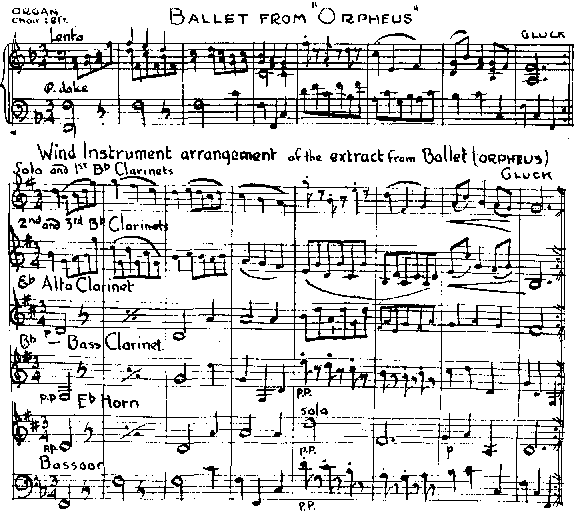Military Band Arranging
Arranging for Military Band from Organ Scores was partially explained in the March 1921 issue of the Musician. The keyboards (Manual and Pedal), the various "Stops" and the registration of their real sound was described therein. Also the opening bars of Du Bois' "Grand Chorus" for organ was scored for full band to illustrate the Wind Band parallel to the "Great Organ."
Scoring for smaller combinations of wind instruments to parallel the "Swell" and "Choir Organ," which are really components of the Great Organ, will now be considered.
As previously stated, the wind band parallel to the Swell Organ would, as a general rule, include all reeds, flute, and light brass, viz:--Flue, Oboe, Bassoon, All Clarinets (Eb, Bb, Alto, and Bass), Alto, Tenor, and Baritone Saxophones, Cornets, Flugelhorns, French Horns, and Euphonium. It is not always necessary, nor desirable, to use all instruments in a continuous tutti, when scoring from the Swell Organ part, but a judicious selection should be made from among them, and care taken not to overload the score. Careful study of the registers of the "Stops" should be made. As before noted, the 2-foot stops will sound two octaves higher, 4-foot stops one octave higher, 8-foot stops as written, 16-foot stops one octave lower, and 32-foot stops two octaves lower than written, in the organ score.
The Choir Organ could be paralleled with the following instruments: Flute and all reeds, except the Ten or, Baritone and Bass Saxophones. One Flugelhorn or cornet, two French horns, and one Euphonium would be sufficient brass. Similarly with the instructions given for the Swell Organ instrumentation, care should be taken not to score too heavily.
The accompanying extract from Gluck's "Orpheus" Ballet No. 18, written for the Choir Organ (8-ft. stops), is arranged for 4 Bb Clarinets, Alto Clarinet, Bass Clarinet, French Horn and Bassoon (see illustration, No. 1 and No. 2). The second part of the ballet, immediately following the extract, given herewith, would require the use of a flute and oboe, and perhaps a cornet, or flugelhorn.
In conclusion, it may be well to mention the fact that to arrange well from organ scores, or any other for that matter, the student must, experiment considerably with passages requiring only a few instruments to record them, that is, if he desires to do the work well. Therefore, a band should always be available for the use of the student, that, he might hear his work played. It, is often necessary to "cue" extensively in passages where a mixture of certain brass and reed instruments are needed, in order that a careful selection of the best sounding combination may be made after the tryout, with the band. There are no set rules for the student arranger to follow. Work, continuous and incessant, if he have sufficient theoretical foundation to carry it forward, will alone bring results. The arranger should practice as diligently with his pen as the successful performer must, with his instrument.

